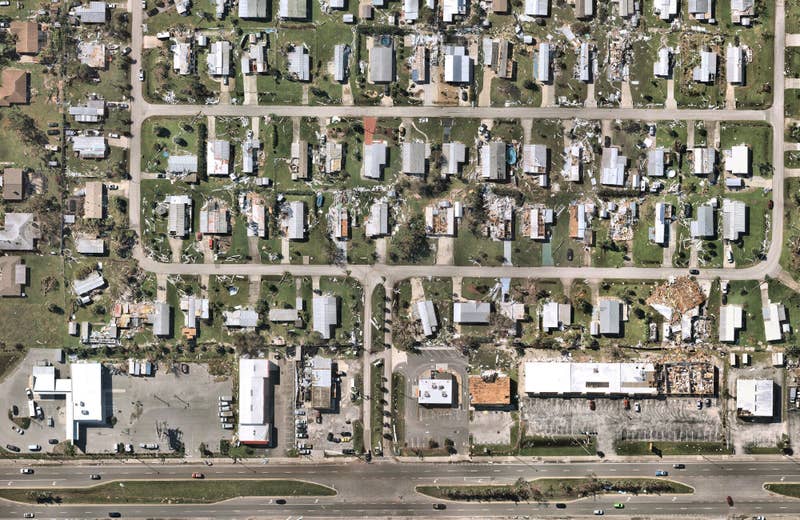
Introducing: Nearmap for Post-catastrophe Response
Post-catastrophe imagery and AI-derived property damage and condition data unite to help insurers process customer claims more efficiently.

Post-catastrophe imagery and AI-derived property damage and condition data unite to help insurers process customer claims more efficiently.
Hurricane Ian, a Category 4 storm, made its impact felt across Florida and the Carolinas — resulting in an estimated $67 billion in insured losses. With two separate landfalls, record winds, and unimaginable damage, the event requires immediate action to help the millions affected. Nearmap ImpactResponse, our proactive post-capture program, photographed the aftermath of Hurricane Ian in Florida on 9/29 (the day after landfall) — with imagery available 9/30. The high-resolution visuals of Hurricane Ian — comprised of 72 total surveys across 34 regions — provided 14,665km2 of invaluable insights within days of the event to help insurers and governments get started on their recovery efforts right away.
Using the Hurricane Ian flyovers and our newly-developed AI for Nearmap ImpactResponse, we were able to automatically identify 136,000 pieces of structurally damaged roof as well as debris and other infrastructure damage. The inspection-grade imagery combined with advanced tools empower insurers and governments to rapidly determine heavily impacted areas and triage support to those who need it most. Making this imagery available as soon as possible is our top priority, and it takes a giant effort to meet the demands for speed and quality.
Survey operations take a lot into consideration before, during, and after a post-catastrophe flight. The first set questions that need to be answered include: what is the magnitude of this impact and when can we safely have a plane on location for capture? If there isn’t a pilot close by, can we safely get one to the area?
Once we’ve identified an event and verified that we can capture it, the team looks to the weather forecast to ensure that there are no remaining threats that would put our pilots in danger. Further, our users rely on Nearmap ImpactResponse surveys to be high resolution, so the forecast has to be clear enough to allow for crisp imagery without much obstruction.
With a flight time determined, internal and external communication channels are set to create a fluidity across each stage of the post-catastrophe survey process. This includes understanding realistic timeframes between capture and publish dates, as well as the logistics of ensuring viable data as it goes from the aircraft to our office. Every decision and step is strategically made with the goal of quick, efficient, and safe outcomes for all involved with gathering post-disaster aerial imagery.
The survey operations team uses computer models to help pinpoint severe weather threats and prepare backup plans around weather models and tracking conditions for best possible capture. Determining the right capture window requires an understanding of where the clouds are and ideating a backup plan for pilots in the event of impaired visuals.
Plan in motion, our team can then get an aircraft to the optimal location, meaning an airfield with the necessary accommodations and amenities. When it’s safe to fly, our pilots conduct multiple captures at varying altitudes to ensure that the resulting images are as clear as possible.
Once the imagery has been captured, the aerial data is flown directly to survey operations for a thorough quality analysis before being published. Approved captures are then made available on-demand for Nearmap ImpactResponse users.
Gulf States Insurance is a company of 25 and underwrites an approximate $60 million in premiums yearly across Alabama, Louisiana, and Mississippi. When Hurricane Ida distressed the lives of many of their policyholders, Gulf States needed immediate access to post-catastrophe imagery to help triage claims. With Nearmap ImpactResponse, the Gulf States team was able to remotely inspect their policies in force in real time as the first notice of loss reports were coming in.
The speed at which Gulf States was able to access Hurricane Ida imagery enabled their team to quickly prioritize customer support and payouts. Being able to see which properties had been heavily impacted helped to determine where to send adjusters and which policyholders needed relief sooner. All of this has improved Gulf States’ customer service by unlocking new post-catastrophe efficiencies and providing the aerial data needed to pair the right support to the right customers.
View Gulf States presentation during NAVIG8 2022:
The rise in weather related events requires our collective attention. From Hurricane Ian in southern Florida, to the Dixie Fire in California, to flooding in Tennessee, our world can be impacted in a moment’s notice. Nearmap ImpactResponse helps us visualize the aftermath of these events and understand the best path toward recovery. Getting the data from our planes into your hands days following an event takes an incredible effort, but the work is worth the mission of helping to accelerate your assessment, response, and recovery.
Learn more about our Nearmap ImpactResponse program.
While we make every effort to ensure the accuracy of the data and analysis in blog articles, this information is not to be relied on as professional advice. No endorsement or approval of any third parties or their advice, opinions, information, products or services is expressed or implied by any information in the blog. Should you seek to rely in any way whatsoever upon this content, you do so at your own risk.

